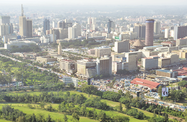A rebound in agriculture and a return to political stability have helped strengthen the momentum of Kenya’s economy in 2018, with the rollout of large infrastructure projects expected to see this growth continue in the medium term.

The IMF forecasts GDP will expand by 6% in 2018, an increase on the 4.9% growth recorded in 2017. The fund’s forecast was supported by data from the Kenya National Bureau of Statistics (KNBS), which showed that GDP had expanded by 6.3% year-on-year (y-o-y) in the first three quarters of 2018.
A major factor behind the stronger growth rates has been an improved agricultural sector, which suffered in 2017 due to a severe drought that affected large parts of the country.
The sector, which accounted for 31.5% of GDP in 2017, rose by 14.2% y-o-y across the first three quarters of 2018, with improved rainfall supporting stronger yields.
Political stability drives increased spending
In addition to more favourable climatic conditions, the KNBS cited improved political stability as a factor supporting growth in 2018.
On March 9 political rivals Uhuru Kenyatta, the winner of 2017’s presidential election, and opposition leader Raila Odinga committed to work together to ensure stability. The rapprochement came after Odinga staged an unofficial swearing-in ceremony declaring himself as the “people’s president” on January 31, raising the spectre of further unrest after the results of both the August and October 2017 polls were disputed.
Political reconciliation soon paid economic dividends, with wholesale and retail trade expanding by 6.9% y-o-y over the first nine months of 2018, accompanied by a 14.9% y-o-y increase in the accommodation and restaurant sector, according to KNBS figures.
This wider stability also helped the local currency maintain its position against the dollar, with the shilling trading at 101.81 to the greenback as of December 28. Having opened 2018 at 103.29 to the dollar, the shilling managed to avoid the volatility that beset many currencies in developing countries during the past year.
See also: The Report – Kenya 2018
Higher taxes affecting consumer sentiment
Despite the impressive results in certain sectors, some of the positive sentiment in the marketplace appears to have given way to a more cautious approach to spending in the second half of the year.
While the Nielson Consumer Confidence Index rose from 94 in the fourth quarter of 2017 to 104 by the middle of 2018, the ranking dropped sharply in the third quarter to fall back to 94, with the company citing the September 1 implementation of a 16% value-added tax on petroleum products as a major factor behind the results.
The introduction of the tax also saw inflation rise from 4.04% in August to 5.71% in December, according to the KNBS. In breaking down the spread of inflation, while food and non-alcoholic beverage costs had risen by a moderate 2.5% between December 2017 and December 2018, a result of improved agricultural production, the price of transport (14.3%), and housing, water, electricity, gas and other fuels (13.5%) recorded double-digit growth over the period.
Big Four infrastructure plans to support 2019 growth
Despite an increase in the cost of key products, the positive performance of 2018 is expected to continue in the near future, with the IMF predicting growth of 6.1% in 2019 as the government continues with the rollout of major infrastructure projects.
The country’s “Big Four” plan, which focuses on increasing investment in affordable housing, manufacturing, food security and universal health care, is expected to gain momentum in 2019 following the implementation of a series of pilot programmes.
Such initiatives include the construction of 500,000 low- and medium-cost housing units at a cost of KSh1.3trn ($12.7bn), which is expected to feed into construction and manufacturing growth.
Elsewhere, the continued rollout of major transport infrastructure projects approved as part of the 2018/19 budget should also have a broader impact on the economy, with KSh207.3bn ($2bn) in state funding set aside for such developments over the fiscal year, which ends on June 30.
Major projects include the upgrade of the road network, phase two of the national standard-gauge railway project, the Mombasa Port Development Project and other investments in aviation infrastructure.
Concerns raised over debt amid fiscal deficit challenges
While these developments are expected to help drive growth, ratings agency Moody’s warned in December that Kenya was likely to miss its fiscal deficit target for 2018.
The agency forecast the deficit to stand at 6.5% by the end of 2018, down on the 7.1% recorded six months earlier, but still above the Treasury’s initial projection of 5.7%.
Furthermore, with lower-than-expected revenue and the requirement to start servicing the initial tranche of its KSh280bn ($2.7bn) eurobond in mid-2019, Moody’s said it expected there to be only a gradual reduction in the government’s primary deficit going forward, with total public debt to increase from 57% of GDP to 60% in the next three years.
Constraints on its credit rating, currently set at "B2" with a stable outlook by Moody’s, and concerns over debt levels could place pressure on the funding of future initiatives.


